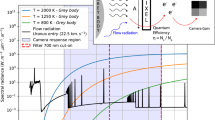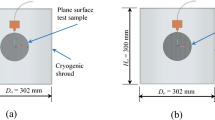Abstract
The application of thermography to thermal vacuum (TV) testing of spacecrafts is becoming a vital additional tool in the mapping of structures during thermal cycles and thermal balance (TB) testing. Many of the customers at the European Space Agency (ESA) test centre, European Space Research and Technology Centre (ESTEC), The Netherlands, now make use of a thermal camera during TB-TV campaigns. This complements the use of embedded thermocouples on the structure, providing the prospect of monitoring temperatures at high resolution and high frequency. For simple flat structures with a well-defined emissivity, it is possible to determine the surface temperatures with reasonable confidence. However, for most real spacecraft and sub-systems, the complexity of the structure’s shape and its test environment creates inter-reflections from external structures. This and the additional complication of angular and spectral variations of the spacecraft surface emissivity make the interpretation of the radiation detected by a thermal camera more difficult in terms of determining a validated temperature with high confidence and well-defined uncertainty. One solution to this problem is: to map the geometry of the test specimen and thermal test environment; to model the surface temperatures and emissivity variations of the structures and materials; and to use this model to correct the apparent temperatures recorded by the thermal camera. This approach has been used by a team from NPL (National Physical Laboratory), Psi-tran, and PhotoCore, working with ESA, to develop a 3D thermography system to provide a means to validate thermal camera temperatures, based on a combination of thermal imaging photogrammetry and ray-tracing scene modeling. The system has been tested at ESTEC in ambient conditions with a dummy spacecraft structure containing a representative set of surface temperatures, shapes, and spacecraft materials, and with hot external sources and a high power lamp as a sun simulator. The results are presented here with estimated temperature measurement uncertainties and defined confidence levels according to the internationally accepted Guide to Uncertainty of Measurement as used in the IEC/ISO17025 test and measurement standard. This work is understood to represent the first application of well-understood thermal imaging theory, commercial photogrammetry software, and open-source ray-tracing software (adapted to realize the Planck function for thermal wavebands and target emission), and to produce from these elements a complete system for determining true surface temperatures for complex spacecraft-testing applications.






















Similar content being viewed by others
Notes
For the tests at ESTEC the 2× MWIR cameras were calibrated by the manufacturer FLIR and the LWIR camera was calibrated at NPL traceable to ITS90.
References
Simpson, R., Broussely, M., Edwards, G., Robinson, D., Cozzani, A., Casarosa, G.: Thermography during thermal test of the GAIA deployable sunshield assembly qualification model, in the ESTEC large space” simulator. In: 12th European Conference on Spacecraft Structures: Materials and Environmental Testing, March 2012
Casarosa, G., Appolloni, M., Cozzani, A., Sablerolle, S.: Development and qualification of an Infrared camera system for thermo-graphic applications in TV-TB conditions. In: Proc. 25th Aerospace Testing Seminar, California, USA, 621 (2009)
Parian, J.A., Cozzani, A., Appolloni, M., Casarosa, G.: New developments with design and construction of a thermal/vacuum qualified videogrammetry system. ISPRS J Photogramm Remote Sensing 64(3), 317–327 (2009)
Parian, J.A., Cozzani, A., Appolloni, M., Casarosa, G.: Validation of a strategy for deformation monitoring of the herschel spacecraft under ambient conditions by photogrammetry. In: 24th aerospace testing seminar (ATS), Manhattan Beach, California, USA, 8–10 April (2008)
DeWitt, D.P., Nutter, G.D.: Theory and practice of radiation thermometry. Wiley Interscience, New York (1988)
International des Poids et Mesures, 78th meeting, 1989, pp. T1–T21 (French version) and pp. T23–T42 (in English)
Planck, M.: On the law of distribution of energy in the normal spectrum. Ann Phys 4, 553 (1901)
Saunders, P.: Correcting radiation thermometry measurements for the size-of-source effect. Int J Thermophys 32, 1633–1654 (2011)
Acknowledgements
The authors are grateful to NPL colleagues Aaron Whittam and Thomas Fletcher for the development of supporting test systems at NPL and ESA colleague, Matteo Appolloni, for the design of the ESA test dummy (TEDY) and technical and engineering advice to the team throughout the project.
Author information
Authors and Affiliations
Corresponding author
Rights and permissions
About this article
Cite this article
Robinson, D.W., Simpson, R., Parian, J.A. et al. 3D thermography for improving temperature measurements in thermal vacuum testing. CEAS Space J 9, 333–350 (2017). https://doi.org/10.1007/s12567-017-0167-3
Received:
Revised:
Accepted:
Published:
Issue Date:
DOI: https://doi.org/10.1007/s12567-017-0167-3




